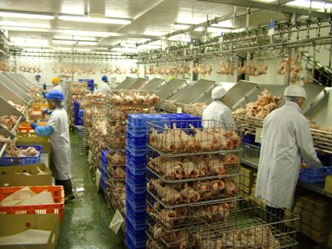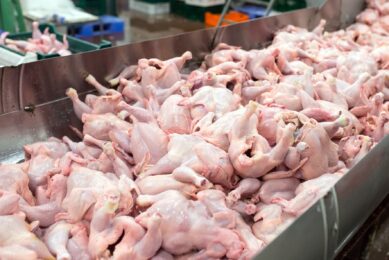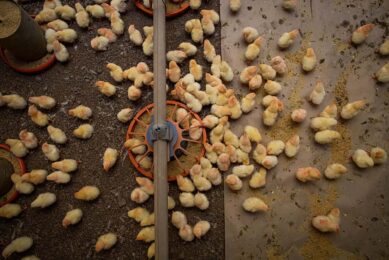Poultry meat demand on an upward spiral

The meat market is a global business and poultry meat is a major part of it. But what does the future hold and where are the threats and opportunities? Shifts and patterns are analysed here.
By Philip Clarke, Poultry World, UK
The global meat market is very much in the ascendency and poultry meat in particular has an important role to play in meeting the increasing demand for animal protein (Figure 1). According to a new multi-species study by international meat consultants Gira, total demand for meat is set to grow by 40 million tonnes over the next 10 years, equivalent to a 14% expansion. About a third of this will be in China – the new economic powerhouse – and around 60%, or 24 million tonnes, will be for poultry meat, mainly chicken.
This domination by poultry reflects the fact that it is the cheapest form of animal protein, says one of the report authors Richard Brown, and will be at the expense of the red meat sector in particular. Gira also estimates that poultry meat will grow at double the rate of the pig meat sector, overtaking pork as the number one meat in the world by 2020. The total meat trade is also set to grow by 18%, with poultry again the dominant force. But exactly how soon these trends will establish, and how accurate the forecasts will be, remains to be seen. Certainly they differ from when Gira conducted the same exercise in 2007.
For example, the 40 million tonne increase in total global meat consumption is less than previously forecast, reflecting the impact of the credit crunch on per capita income gains in the emerging economies. Gira’s forecast for the growth in the poultry sector however, has been revised upwards, as it represents better value for consumers than other meats. “There is still a great deal of uncertainty,” says Brown. “After all the turmoil of 2008, we are now seeing new growth in the global economy. But the recovery is weak and there are questions about whether it will be sustained and whether the UK and/or the USA will face a double-dip recession. Also, can we really believe the tremendous growth figures now coming out of China and India?”
Consumption trends
Looked at in more detail, Gira says the trend towards stronger demand for poultry meat is broadly spread, with all countries seeing some increase over the next decade.
Looked at in more detail, Gira says the trend towards stronger demand for poultry meat is broadly spread, with all countries seeing some increase over the next decade.
As well as the price advantage, poultry meat also enjoys shorter preparation times than other meats, is versatile as an ingredient and is not subject to religious restriction. Improvements in deep chilling technology also means that “fresh” poultry now has a longer shelf life and can be transported further, while consumer confidence in the product following H5N1 has been restored. The Gira analysis points to particular growth in the USA, South America, Russia, the Middle East and China (see Figure 2).
In the USA, where poultry meat sales are dominated by breast meat, economic recovery will help push the market forward. But the real driver is population growth, especially in the lower income groups and the Hispanic immigrant sector. “US consumers are also less sensitive to welfare issues than the EU, helping strengthen poultry meat’s popularity,” says Brown. The typical American already consumes more than double the world average volume of poultry meat, at 53 kg per person per year, and five times as much as the average Chinaman.The picture in South America is also positive, with strong economic growth in Brazil, Argentina and Chile. Argentina in particular is expected to see consumption increase by 4% a year for the next five years, while Brazil is slightly more muted.“Poultry meat consumption in Brazil will near maturity in the long run, with consumers favouring beef which, with increased disposable incomes, will become more affordable.”
China takes the lead
Russia, meanwhile, will see continued strong growth from a low base, while the Middle East market will expand quickly due to the preference for poultry as part of a Muslim diet and rapid population growth. But the most significant increase in poultry meat consumption will be in China, again due to its affordability and suitability for everyday Chinese cooking. Consumer confidence is also recovering fast from the impact of the H5N1 and SARS outbreaks of recent years. Chinese poultry meat consumption is forecast to grow by 5.4 million tonnes in the next ten years to almost 18 million tonnes, or from 9.7 kg to 13 kg per person per year.
Russia, meanwhile, will see continued strong growth from a low base, while the Middle East market will expand quickly due to the preference for poultry as part of a Muslim diet and rapid population growth. But the most significant increase in poultry meat consumption will be in China, again due to its affordability and suitability for everyday Chinese cooking. Consumer confidence is also recovering fast from the impact of the H5N1 and SARS outbreaks of recent years. Chinese poultry meat consumption is forecast to grow by 5.4 million tonnes in the next ten years to almost 18 million tonnes, or from 9.7 kg to 13 kg per person per year.
Gira also sees some further expansion of the European market, especially in eastern Europe where incomes are still increasing. There will also be an increase in demand for welfare-friendly poultry meat, which will push up the “spend” if not the volume.“It’s often said that the EU market is saturated,” says Brown. “Certainly it’s mature, but there is still room for some growth.”
Volume from Brazil and US
So with global demand for poultry meat on the increase, where is all the additional meat going to come from?
According to Brown, much of it will be indigenous, produced in the country or region where it is needed, but not exclusively so (Figure 3).
The USA and Brazil in particular are where the greatest rises in output will be seen and are the two main countries that will also have significant export surpluses to trade (Figure 4). The USA is expected to put on another 3.3 million tonnes of poultry meat production in the next 10 years to over 22.7 million tonnes, driven by the huge scale of the US processing industry, the buoyant domestic demand and the large availability of feed grain. The relative weakness of the US dollar will also help the export trade, especially leg meat to the Middle East and North Africa. Gira estimates that the USA will increase its total poultry meat exports from 2.97 million tonnes this year to 3.67 million tonnes in 2020.
Brazil is also expected to see its output grow faster than its demand, and could be shipping over 5 million tonnes of poultry meat by 2020, a rise of almost 20%. “The Brazilians think in terms of scale, they have a supportive government and have the feed grain production to go with it,” says Brown.
“The rate of export growth from Brazil has slowed in recent years as the Real has strengthened,” he adds. “But they have good access to most markets, including whole birds to the Middle East, breast meat to Europe, legs to Japan and by-products to China.” Brazilian exports to the EU are expected to be maintained at a steady 0.5 million tonnes a year.
Strong new players
The other producer to watch is Thailand, which is forecast to almost double its exports to 1.2 million tonnes by 2020, mostly to the Middle East, Japan and China, but also cooked meat to the EU.
The other producer to watch is Thailand, which is forecast to almost double its exports to 1.2 million tonnes by 2020, mostly to the Middle East, Japan and China, but also cooked meat to the EU.
“Thailand has a huge supply of cheap, skilled workers and has really pushed forward in terms of adding value,” says Brown. “It used to be a producer of commodity chicken, before avian flu hit. Since then, they have invested in cooked and processed poultry meat and they are very good at it.”The other two big players are Russia and China. Both are driven by governments determined to increase their food production levels over the next 10 years. In Russia, Prime Minister Vladimir Putin has pledged to achieve self-sufficiency by 2015 and has even talked of being a net exporter by then. With this in mind, it is noticeable that a number of Western poultry companies have set up shop within the Russian borders in recent years.
According to Gira’s analysis, Russia is likely to almost double production in the next 10 years to 5.3 million tonnes. Imports are also likely to drop significantly, from 890,000 tonnes to just 200,000 tonnes. But self-sufficiency looks a little unlikely. And it’s a similar story in China where the government strategy is to boost domestic meat production. Imports will still be important, however, and are forecast to actually increase from 890,000 tonnes to 1.47 million tonnes by 2020.
“Brazil won’t be shipping chicken to China in the future, but it will be shipping soya to feed all the extra birds,” says Brown. But while Russia and China are working to reduce their dependency on imports, the same cannot be said of the Middle East and North Africa, where production will struggle to keep up with growing consumption, despite widespread subsidisation (Figure 5).
Gira’s analysis suggests the 20 countries that make up the region could be importing over 4.3 million tonnes of poultry meat in 2020, compared with 2.7 million tonnes this year, representing a good opportunity for poultry meat exporters.
Match rise in demand
Against this background of strong and growing demand, Brown says the world poultry sector should benefit from better prices, so long as it does not fall into the trap of over-production. “Poultry production is pretty flexible and can be turned on and off more quickly than some other forms of livestock production,” says Brown. “If the integrators do their forecasting right, they can increase production slowly to match the rise in demand.
“The EU industry has been very sensible in this respect, expanding slowly and allowing prices to rise to cover feed costs. They realise that it’s not all about volume, but about control.
“But the Americans and Brazilians have not always been so smart, pushing for incremental tonnage and ending up flooding the market. The hope must be that they have learned that lesson.”
Forces for charge • The world economy– are we back to growth or is a “double dip” recession on the cards? • Currency– will the US dollar stay weak and will the Brazilian Real stay strong, and what will it mean for trade? • Disease– will H5N1 return and what will be the effect on supply and demand? Will the poultry sector be hit by other food scares? • Climate change– how will changing weather patterns impact on grain production and the cost of feed? • Sustainability– will concerns about long term food availability lead to more protectionism? • Trade– what will be the effect of WTO and Mercusor trade talks? • Oil– will oil stay at 80 USD a barrel and how will this affect food production costs? • Supply chain factors – what will be the impact of the continuing amalgamation of global meat businesses? |
Join 31,000+ subscribers
Subscribe to our newsletter to stay updated about all the need-to-know content in the poultry sector, three times a week. Beheer
Beheer











 WP Admin
WP Admin  Bewerk bericht
Bewerk bericht